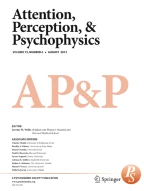Abstract
Currently, it is not known by which mechanisms novel visual representations are stored in long-term memory (LTM). Here we report evidence that visual working memory (WM) plays an important role in the formation of visual LTM. By varying exposure times and perceptual difficulty of the stimuli, we find that the rate-limiting factor constraining storage in LTM is the amount of information that can be simultaneously kept in WM, whereas the time needed to store this information into LTM is constant irrespective of the size of the WM content. These results support the hypothesis that visual WM serves as a gate for the storage of information into LTM.
Article PDF
Similar content being viewed by others
Avoid common mistakes on your manuscript.
References
Alvarez, G. A., &Cavanagh, P. (2004). The capacity of visual shortterm memory is set both by visual information load and by number of objects.Psychological Science,15, 106–111.
Awh, E., &Jonides, J. (2001). Overlapping mechanisms of attention and spatial working memory.Trends in Cognitive Sciences,5, 119–126.
Baddeley, A. (1992). Working memory.Science,255, 556–559.
Brockmole, J. R., Wang, R. F., &Irwin, D. E. (2002). Temporal integration between visual images and visual percepts.Journal of Experimental Psychology: Human Perception & Performance,28, 315–334.
Chase, W. G., &Ericsson, K. A. (1981). Skilled memory. In J. R. Anderson (Ed.),Cognitive skills and their acquisition (pp. 141–189). Hillsdale, NJ: Erlbaum.
Chase, W. G., &Simon, H. A. (1973). The mind’s eye in chess. In W. G. Chase (Ed.),Visual information processing. New York: Academic Press.
Cowan, N. (2001). The magical number 4 in short-term memory: A reconsideration of mental storage capacity.Behavioral & Brain Sciences,24, 87–114.
Craik, F. I. M., &Lockhart, R. S. (1972). Levels of processing: A framework for memory research.Journal of Verbal Learning & Verbal Behavior,11, 671–684.
Ericsson, K. A., &Kintsch, W. (1995). Long-term working memory.Psychological Review,102, 211–245.
Gobet, F., &Simon, H. A. (1998). Expert chess memory: Revisiting the chunking hypothesis.Memory,6, 225–255.
Greene, R. L. (1987). Effects of maintenance rehearsal on human memory.Psychological Bulletin,102, 403–413.
Hollingworth, A. (2004). Constructing visual representations of natural scenes: The roles of short- and long-term visual memory.Journal of Experimental Psychology: Human Perception & Performance,30, 519–537.
Hollingworth, A., Hyun, J. S., &Zhang, W. W. (2005). The role of visual short-term memory in empty cell localization.Perception & Psychophysics,67, 1332–1343.
Irwin, D. E., &Andrews, R. V. (1996). Integration and accumulation of information across saccadic eye movements. In T. Inui & J. L. Mc-Clelland (Eds.),Attention and performance XVI: Information integration in perception and communication (pp. 125–155). Cambridge, MA: MIT Press.
Jiang, Y. H., Olson, I. R., &Chun, M. M. (2000). Organization of visual short-term memory.Journal of Experimental Psychology: Learning, Memory, & Cognition,26, 683–702.
Kane, M. J., Hambrick, D. Z., &Conway, A. R. A. (2005). Working memory capacity and fluid intelligence are strongly related constructs: Comment on Ackerman, Beier, and Boyle (2005).Psychological Bulletin,131, 66–71.
Kemps, E. (2001). Complexity effects in visuo-spatial working memory: Implications for the role of long-term memory.Memory,9, 13–27.
Luck, S. J., &Vogel, E. K. (1997). The capacity of visual working memory for features and conjunctions.Nature,390, 279–281.
Miller, G. A. (1956). The magical number seven plus or minus two: Some limits on our capacity for processing information.Psychological Review,63, 81–97.
Murnane, K., &Shiffrin, R. M. (1991). Interference and the representation of events in memory.Journal of Experimental Psychology: Learning, Memory, & Cognition,17, 855–874.
Oh, S. H., &Kim, M. S. (2004). The role of spatial working memory in visual search efficiency.Psychonomic Bulletin & Review,11, 275–281.
Olsson, H., &Poom, L. (2005). Visual memory needs categories.Proceedings of the National Academy of Sciences,102, 8776–8780.
O’Regan, J. K., Rensink, R. A., &Clark, J. J. (1999). Change-blindness as a result of “mudsplashes.”Nature,398, 34.
Pashler, H. (1988). Familiarity and visual change detection.Perception & Psychophysics,44, 369–378.
Phillips, W. A. (1983). Short-term visual memory.Philosophical Transactions of the Royal Society of London: Series B,302, 295–309.
Phillips, W. A., &Christie, D. F. M. (1977). Components of visual memory.Quarterly Journal of Experimental Psychology,29, 117–133.
Prabhakaran, V., Narayanan, K., Zhao, Z., &Gabrieli, J. D. (2000). Integration of diverse information in working memory within the frontal lobe.Nature Neuroscience,3, 85–90.
Pylyshyn, Z. W., &Storm, R. W. (1988). Tracking multiple independent targets: Evidence for a parallel tracking mechanism.Spatial Vision,3, 179–197.
Treisman, A. [M.] (1982). Perceptual grouping and attention in visual search for features and for objects.Journal of Experimental Psychology: Human Perception & Performance,8, 194–214.
Treisman, A. M., &Gelade, G. (1980). A feature-integration theory of attention.Cognitive Psychology,12, 97–136.
Wheeler, M. E., &Treisman, A. M. (2002). Binding in short-term visual memory.Journal of Experimental Psychology: General,131, 48–64.
Woodman, G. F., &Luck, S. J. (2004). Visual search is slowed when visuospatial working memory is occupied.Psychonomic Bulletin & Review,11, 269–274.
Woodman, G. F., Vecera, S. P., &Luck, S. J. (2003). Perceptual organization influences visual working memory.Psychonomic Bulletin & Review,10, 80–87.
Author information
Authors and Affiliations
Corresponding author
Additional information
This work was partially supported by Alexander von Humboldt-Stiftung and by the Hertie Foundation.
Rights and permissions
About this article
Cite this article
Nikolić, D., Singer, W. Creation of visual long-term memory. Perception & Psychophysics 69, 904–912 (2007). https://doi.org/10.3758/BF03193927
Received:
Accepted:
Issue Date:
DOI: https://doi.org/10.3758/BF03193927




